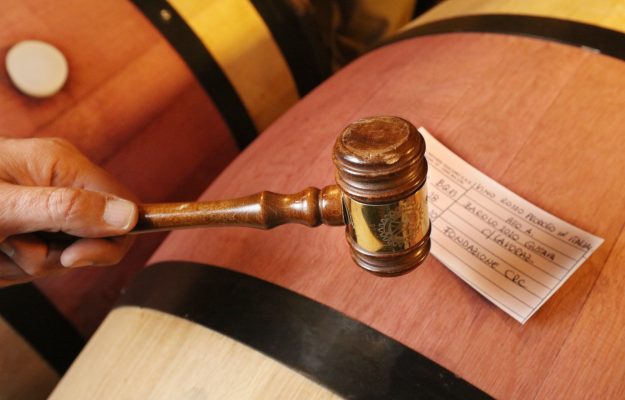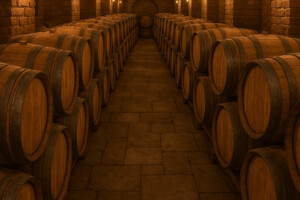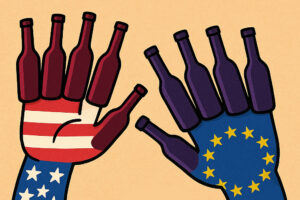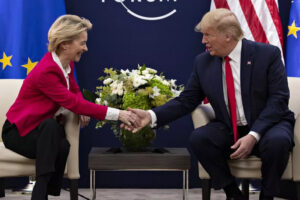The Italian fine wine auction market, a fundamental channel for the large secondary market of fine wines, closes a decidedly positive 2022, which confirms the goodness of wine as an asset in which to invest even in the most difficult times, registering, however, also some signs of a slowdown in the unrestrained race of the quotations of the top brands. Symptoms that should not be underestimated, but which the auction houses of Italy, heard by WineNews, are very clear on how to deal with in a 2023 that promises to be particularly complex. The first datum, which unites all the players, from Pandolfini to Bolaffi, from Finarte to Gelardini & Romani, from Wannenes to Il Ponte, is the security that can be placed in that small circle of labels capable of representing a true safe haven asset.
From the greats of Burgundy, such as Romanée-Conti, Rousseau, and Jayer, to the granitic certainties of Italy, such as Sassicaia, Masseto, Tignanello (Antinori), Case Basse (Soldera), Giacomo Conterno, Bruno Giacosa, Bartolo Mascarello, Gaja’s wines: these are the wines that led the turnovers of 2022, and are unlikely to abdicate in 2023. Beware, however, of what the latest Liv-ex report has already pointed out: the prices of certain labels, starting with Romanée-Conti, have reached such high levels that their further valorization is very difficult, and auction houses will also have to take this into account.
Especially because the higher the prices, the fewer collectors are willing to pay them. It is no coincidence, then, that at least in Italy there is great attention to that large segment of enthusiasts, not necessarily well-to-do, willing, however, to invest even small sums in wine. Either in a speculative logic, or with the much more concrete goal of investing in a good that can really be enjoyed, bringing important bottles to the table.
A road already taken, with auctions, especially online, made up of hundreds of lots that are absolutely accessible, and wines that, little by little, have built up a credibility of international caliber, because they are capable of guaranteeing an enormous constancy in quality, the right exit price, and consequently the ability to guarantee, to investors, interesting margins. This is the groove within which, for example, we find wines such as Montevertine’s Le Pergole Torte and San Leonardo, absolute protagonists of 2022 Italian wine auctions, alongside the “usual” sacred monsters.
In terms of turnover, a relative value because it is given by the number of auctions and, of course, the value of the lots auctioned, the only auction house to exceed 3 million euros was Pandolfini, with the two online auctions and, above all, the auctions in presence in April (which garnered 1.47 million euros in adjudications, with a six-liter of Masseto 2007 auctioned at 11,250 euros, ed.), and November, which well tell the year’s performance. “The April auction reached crazy prices, while the November auction, which nevertheless went well, showed a certain fatigue of Burgundy, which may have peaked with the most important names. 60% of investments come from Italy, 40% from abroad, especially Europe, then the U.S. and Hong Kong”, Francesco Tanzi, head of Pandolfini’s fine wines and whisky and distilled spirits collectibles department, tells WineNews, who then points out that “investments from the East, on which the further growth of top labels depends to a good extent, have stopped”.
“There has been some sign from Champagne, with respect to particular selections and formats, such as the case of Salon awarded at 9,000 euros, and Pétrus always performs very well, although Bordeaux, in general, has two limitations: so many bottles produced and prices that are already high to begin with. Italy, on the other hand, still guarantees attractive prices that allow big margins, from Pergole Torte to Sassicaia, from Monfortino to Soldera, an exclusive club in which San Leonardo is making its way. Auctions, for companies, are a point of arrival, behind them you need an important history or sustained investment, as in the case of Masseto and Ornellaia, while in other cases, such as that of Monfortino, the merit is quotations based on the secondary market”. Looking ahead to 2023, “I do not think there are any downturns or problems in sight for Italian auctions. It is difficult to imagine a further valorization of Burgundy labels, because they have reached figures that are difficult to exceed. Then there are the global economic dynamics to consider, which also impact investments in fine wines. The important thing”, recalls Francesco Tanzi again, “is that China will restart, but we expect that it will”.
Also decidedly positive was Bolaffi’s 2022, which, as recalled by Bolaffi Auctions Fine Wines and Spirits department specialist Luisa Bianconi, closed the year with a total realization of 2.45 million euros and an average of 98% of lots sold. Among the year’s top lots were the 42 bottles of Masseto (three for each vintage from 2005 to 2018), which totaled 28,800 euros, the 9 bottles of Barolo Monfortino Riserva 2010 by Giacomo Conterno (20,150 euros), the 6 magnums of Barolo Monfortino Riserva 2010 by Giacomo Conterno (17. 280 euros), the 12 bottles of Barolo Monfortino Riserva by Giacomo Conterno, three of each vintage (2010, 2013, 2014 and 2015), batted at 15,800 euros, and another 6 magnums Barolo Monfortino Riserva by Giacomo Conterno (2005, 2008, 2010, 203, 2014 and 2015), at 10,000 euros.
“The most noble producers of Piedmont (Giacomo Conterno, Bruno Giacosa, and Bartolo Mascarello) and Tuscany (Sassicaia, Masseto, Le Pergole Torte) are confirmed as protagonists of the auctions. For France, Bordeaux, even in old vintages, and the prestigious Domaines of Burgundy, especially Romanée Conti, Rousseau, Jayer, are constantly popping up important rises. Despite the international political situation and the energy and economic crisis we are going through, the fine wine market is responding very positively. The trend is not only not negative, but even growing, and we had already ascertained this in pandemic time. The wine sector is proving to be solid and an excellent segment to invest in”, comments Luisa Bianconi.
Different dimensions, but also different expectations, accompanied Finarte’s 2022, in which, says Guido Groppi, department head of wines and spirits, “growth was 10%, but we had higher expectations”. The most positive aspect concerns the “pop” auction, “dedicated to enthusiasts and collectors: involving them in the auction circuit has been one of our goals since 2019, and we achieved it by focusing on affordable bottles thanks to which we saw the room full for the first time. Another important moment for us was the Borgogno monographic auction, which sold 90%. It taught us that a quality Barolo has a relevant market value even at average prices”, comments Guido Groppi.
“The market, when looking at Italy, is always Piedmont and Tuscany, especially with labels like Sassicaia, Masseto and Tignanello. Brunello di Montalcino is also doing well, with Biondi-Santi and Soldera at the top from the point of view of trade, followed by Salvioni, while the young brand is Casanova di Neri, which makes consistently high performances. We’ll see if Wine Spectator’s results bring some effect, thinking of course of Fattoria dei Barbi. The panorama is more varied in Piedmont, with Monfortino, Gaja, Giuseppe Rinaldi and Bartolo Mascarello, a real cult, especially with certain labels and very old vintages, among Barolo, while among Barbaresco, surely Roagna is the producer to watch. The third area is Amarone, which experienced an excellent 2022. Outside these three areas there are the icons such as Valentini, with relevant quotations, higher than many Barolo, or Emidio Pepe, and then from Friuli Miani and Gravner, and some surprises, such as San Leonardo and Pergole Torte, which have put in excellent price escalations, becoming cult and investment brands, and watch in the future for Testamatta”, continues Finarte’s head of wine and spirits department.
“To anticipate the market, one must understand the value of a wine beyond its commercial value: brand building, with rare exceptions, is a long process, the prerequisite for which is always quality over time. Expectations are good for 2023, because if it is true that Champagne and Burgundy are at too high a level to have possibilities for major revaluation, possibilities are opening up for Italian wine. The area in which I would invest-waiting for Etna, which has become unavoidable for all Sicilian producers, with Tenuta delle Terre Nere and Passopisciaro making the price-is instead Northern Piedmont, an area of Nebbiolo with a great tradition. Production has completely changed since Cavour’s time, and the potential is enormous, just think of Conterno’s acquisition of Nervi: this is the area to look at”, concludes Guido Groppi.
A cross-section, as always, very peculiar, is what comes from the words of Raimondo Romani, founder, together with his historical partner Flaviano Gelardini, of Gelardini & Romani Wine Auction, an auction house dedicated to fine wines, born in Rome but now for some years stationed in Hong Kong, gateway to the great Asian and, of course, Chinese market. Raimondo Romani’s is a privileged observatory on an area of enormous relevance for the auction sector, and not only of wine. A world that, since the outbreak of the pandemic in 2020, has moved inexorably away, but not as much as one might imagine from here. “We were scared off by Covid, but it actually brought a great effervescence to the fine wines market. Having passed the emergency phase, we are experiencing a radical change in Asia, in which large trading companies are focusing on disintermediation, aiming directly at the end customer. Working on the private customer, therefore, will become central: in China and Hong Kong this is already the case, while less mature markets still represent excellent opportunities for the trade, albeit with the difficulties related to customs and operators who are still immature, and with whom it is difficult to work from Europe”, says Raimondo Romani, who with Gelardini & Romani Wine Auction, in 2022, had a turnover of 2 million euros, with 50 percent, for the first time, generated by the retail channel, for a total of 1.5 million euros of Italian wine sold between China and Hong Kong.
“From the point of view of auctions, at this time of uncertainty, wine is also affected: Burgundy is growing, but it has hit its highs, Piedmont is going very strongly, while with Bordeaux there is no more money to be made. If so many Italians are going to the Place, it is because there is great demand and they guarantee wide margins. There are several niches with still capacity for growth, like Barolo and Barbaresco, but Brunello and Etna are also doing very well, and then icons like Valentini and Pepe. With France, by now, there is no longer the competition of a few years ago: we are working in synergy, also to overcome the difficulties of the British, who are paying the price of Brexit also and above all in Asia, where certain bottles, at prices that are now out of control, are no longer sold, much less in China, which is even experiencing a moment of deflation”, Romani explains.
“Wines have always had their standard value over the centuries, but since the 1980s the run has been exceptional, at least following the value of the vintage. Today, prices are just growing, reaching saturation, because growth cannot be infinite. We need to go back to thinking about sustainable target prices, because the top labels, when they reach around 1,000 euros per bottle, are at the limit: even the billionaire, before opening a 1,000 euro bottle, thinks twice. The prices of many labels are now consolidating, and now it is the producer who is making money, as is only right. There are cases of vignerons who oppose this dynamic, putting bottles on the market at costs far below the real value, but by doing so they achieve the opposite result, because this is exactly how the speculation market is fed”, Romani warns.
The goal, to bring the market back into balance, “is to have an intermediate price at the winery that allows for a two-and-a-half times revaluation on the secondary market, while ensuring both a fair profit for the winery and a multiplier effect for the investment market. This is what we see, for example, with labels such as Sassicaia or Pergole Torte di Montevertine. In contrast, Solaia and Ornellaia, at the moment, do not allow this, losing appeal, as does Masseto, so much so that Massetino is growing much more in percentage terms. Asian markets are markets that require long-term planning, in an area that experiences wide-ranging geopolitical dynamics, certainly not on a daily basis, it takes 4-5 years for a label to succeed in Asia, here everything is very slow, but aimed at absolute efficiency”, Raimondo Romani concludes.
Among the last auction players to focus on fine wines is Wannenes, with the Wine and Spirits department only born in 2018, and the first auction in 2019, just before the pandemic. “Since 2021, however, we have managed to always do 2-3 auctions a year”, recalls Alessio Leonardi, who heads the Wine and Spirits department. “We have an average sales of 70%, for a turnover, in 2022, of 350,000 euros, to which we can add post-auction sales, which are definitely relevant. Our peculiarity is to propose not only wines for investment, but also to be physically brought to the table. For example, our last auction, which went online only, was divided into two parts: important collections, from Sassicaia 1968 to the first vintage of Tignanello, on the one hand, and more accessible and fun lots on the other. The results tell us that the lots that we can define as “drinkable” have the ability to attract wine lovers and younger collectors, because the market cannot stand only on the very big labels, which, after all, we also deal in. The double magnum of Quintarelli’s 1990 Amarone Riserva, fetched at 5,000 euros, or the vertical of 12 vintages of Ornellaia at more than 3,000 euros, however, are not for everyone”, Alessio Leonardi points out.
Auctions, in this sense, are no longer the exclusive place for speculation; on the contrary, they become an opportunity, because “with the prices of so many labels continually rising already from the cellar, interesting bargains can be found under the hammer, with wines that already have a few years on their shoulders, but at absolutely reasonable costs. In general, however, the last 4-5 years have seen a huge increase in the prices of so many labels, with the risk of being faced with many small bubbles, ready to burst. We need to focus on fairly priced, marketable bottles to the satisfaction of everyone, producers and investors alike. An excellent example comes from Lungarotti, which slowly in our catalog has given interesting results, or Ca’ del Bosco’s Chardonnay, or Jermann’s Vintage Tunina”.
Looking to 2023, “there are regions like Abruzzo and Sicily that are destined to grow, with the wines of Emidio Pepe and Valentini, but also Passopisciaro and Arianna Occhipinti. Looking abroad, Champagne will never die; it has a huge history behind it, despite speculation, because it is, essentially, an irreplaceable product. The Burgundy bubble, on the other hand, deserves an in-depth analysis, but it is not necessarily the case that the labels of Piedmont and Tuscany would be happy to experience such growth rhythms, because the result is inevitably the same, the explosion of the bubble”, concludes Alessio Leonardi.
Finally, the newest addition, Il Ponte Auction House, which, as Enrico Incisa recalls, “held its first auction just a few weeks ago”. With decidedly encouraging results: 88% of lots sold and 133% revaluation of base prices. And under the hammer important lots, such as the two bottles of Richebourg Grand Cru 1993 (fetched 4,125 euros), the twelve bottles of Château Palmer 1990 (2,250 euros), the bottle of Château Margaux 1990 (1,000 euros) and the La Tache Grand Cru 1960 from Domaine Romanée Conti (1,125 euros). What makes Il Ponte’s approach to the world of wine auctions different is “the relationship with our clients: it is with their collections that we build our catalogs. Trying, of course, to build a balanced offer that guarantees the goodness of the investment but without chasing speculative bubbles”.
With ample space for the griffes of Italy that best embody these principles. Starting with “Tenuta San Guido’s Sassicaia and Antinori’s Tignanello, but also Gaja and Ornellaia. Targeting essentially Italian collectors, we have aimed, and will aim, not only at investment lots, but also at accessible labels intended for consumption, an aspect almost forgotten in the world of fine wines. We are taking our first steps, aware that it is a market capable of great satisfaction. We must know how to seize the opportunities that will present themselves to us, but it is certainly a sector, like many other investment sectors, that cannot disregard the small number of labels that move a good part of the market”, adds Enrico Incisa.
Copyright © 2000/2025
Contatti: info@winenews.it
Seguici anche su Twitter: @WineNewsIt
Seguici anche su Facebook: @winenewsit
Questo articolo è tratto dall'archivio di WineNews - Tutti i diritti riservati - Copyright © 2000/2025

























































































































































































